Oh Oscar
oh oscar
More Posts from Stubbytime and Others
how to pick a therapist
A friend recently asked how I found my therapist, who I absolutely adore. I was in a bad place when I first started seeing her, and she has helped me completely turn my life around. The fact is that I saw a lot of bad and mediocre therapists, then finally got lucky. That said, now that I know what a really good therapist is like, I do have some advice for finding one:
Do interview sessions with multiple therapists and take notes on what you like or don’t like. It’s not high maintenance or pushy to ask a lot of questions. You’re a customer looking for someone to provide a service - an expensive service, possibly for a long time. This is someone you will trust with your secrets and your health. Sometimes, your life.
If you’re in a dark place while searching, try to find a level-headed friend or family member to help you interview. The most frustrating thing about mental healthcare is that patients are often too vulnerable and ill to self-advocate and, as a result, often tolerate unacceptable behavior from their mental healthcare providers. Bad providers will blame patient dissatisfaction on patients being unstable. There is little accountability for their performance. If you can’t stand up for yourself, it helps to have a trusted third party that can either come with for interviews or, at the very least, who can talk with you after about your concerns and options. If a therapist asks why you want to bring someone with, simply say, “I’m not mentally able to self-advocate at this time. I am more comfortable having someone with me for support.”
Look for someone who does holistic therapy and/or who talks about using a variety of methods, depending on patient needs. Ask what types of methods they use and if they prefer one over others. A big part of therapy is teaching you a variety tools that will help you cope with stressors. You should expect your therapist to have more than one tool in their arsenal as well.
Ask their opinion on medication. I have met therapists who don’t believe in medication at all and some who won’t even work with patients that aren’t willing to medicate. Personally, I feel the only correct response is, “Medication is an important tool for some people, but it’s not the answer for everyone.”
Ask them what successful therapy looks like to them and what they think the most important things are to be successful in therapy. You want someone who talks about how different patients need different things. For some people, stability is the goal. Others have more specific objectives. The worst sort of therapist is one that uses the same structure for every patient because they’ve decided it’s the “right way.”
During interviews, you do want a therapist to mention that a patient has to be willing to change and give effort. However, you don’t want them to spend an excessive amount of time going on about how YOU have to do the work and “this won’t work if you’re not willing to give it your all” and blah, blah, blah. That is the sign of a therapist that will see therapy not working and immediately say, “Ah, not my fault. They weren’t doing the work,” absolving themselves of any extra work or creative thinking.
The final item is tricky to spot in an initial interview, but it’s crucial. Therapy requires a delicate balance. A good therapist can guide a session and push their patient without being domineering or dismissive. You can spot the domineering therapist fairly easily: they will tell more than they ask, make you feel uncomfortable or self-doubting, and will minimize your wishes or concerns about therapy. The lazy therapist is much more common. They’re not as harmful or obvious as the domineering therapist, but they probably won’t help you. They let you guide therapy, don’t ask many questions, and don’t challenge you. They will let you use therapy as a venting session or allow you to rehash the same handful of traumas without doing any work to process them in a new way. If you find yourself with a domineering or lazy therapist, fire them.
What has made my therapy successful is that my therapist is flexible, adaptable, and willing to try new things and new methods. There were periods where I was actually too ill to do any work, but she never addressed it like, “Ah, She Won’t Do The Work.” She just scheduled us for very frequent sessions and kind of quietly came up with things to keep me busy and stable, monitoring my state for safety until I reached a place where I was able to do the work.
When something didn’t work, it was never my fault, and she never spent any time lamenting that it hadn’t worked. She would just immediately say, "Okay, not this, then. I have something different planned for us to try next week.” Just like that, we were talking about what we were going to do next instead of thinking about the thing that failed.
The mental healthcare world, at least here in the US, is pretty fucked up. For a time, it was definitely doing me more harm than good, and I have trauma from my experiences with bad mental healthcare providers. I think it’s important to talk about patient self-advocacy and provider accountability. I hope the list above will help someone avoid bad providers and get the help they need. If you would signal boost this, I’d really appreciate it.

jackson and danny because i miss them...










Clifford Prince King











Celebrate Pride With These 10 Incredible LGBTQ+ Characters
The 'tension' vs the 'truth' (or a version of it, at least)

i want to live






Even without words, we communicate through our eyes.
Happy valentines day to everyone who has a crush on an animated car
Embroidery 101

Introduction:
Embroidery is a craft that uses thread to decorate fabric (and other materials). It's a great way to spruce up a garment, customise objects, and to hide mends you've made!
Embroidery is usually done with embroidery floss, but depending on the base material you're working on, you could also use yarn, ribbons, or plain old sewing thread. Don't be afraid to experiment!
Embroidery is easier to do on taut fabric than limp fabric. That's why most people use embroidery hoops. While not strictly necessary, a hoop will make your life so much easier.
Using the right needle will help, too. Use a crewel needle if you're working with embroidery floss, a chenille needle if you're working with ribbon or yarn, or a tapestry needle if you're doing cross-stitch embroidery on open-weave fabrics.
While there are many types of embroidery from all over the world, this post will focus on some basic stitches you can use in your own work.
Basic embroidery stitches:
For a more thorough overview of embroidery stitches, check out these embroidery tutorials by Mary Corbet's Needle 'n Thread.
The following images show some of the most basic stitches:

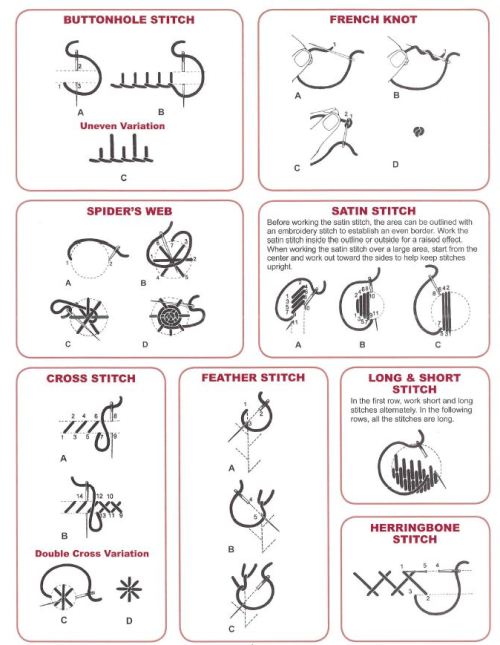
(Image source)
The 16 stitches in the images above can be combined into any shape or form you want. You might recognise some from my hand sewing post: embroidery is a type of hand sewing, after all.
You don't need to know all of these to be able to make beautiful things. Even just one of these is a great start for a project.
This sampler by Sew Nancy shows how these basic stitches can be used to outline shapes or form flowers, for example.
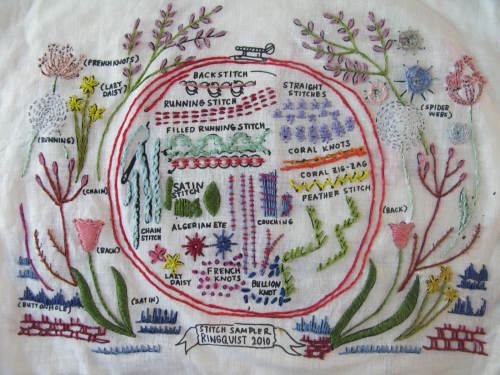
(Image source)
Fiorelila used a combination of the stem stitch, satin stitch, lazy daisy, and french knots to spruce up this sweater:
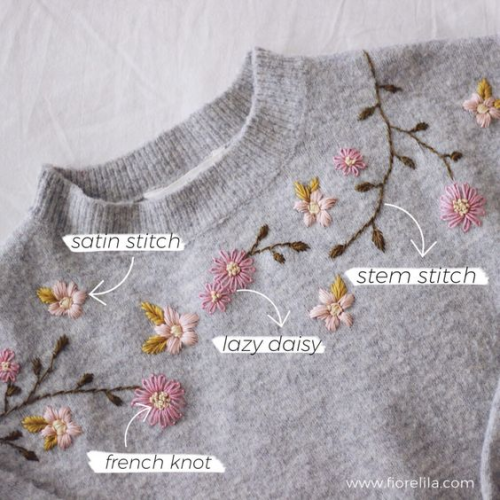
(Image source)
And this person used lazy daisies to add some flair to their jeans:
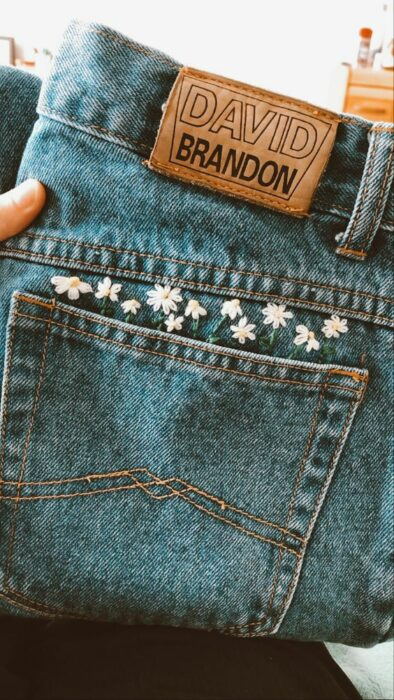
(Image source)
Embroidery for visible mending:
Embroidery is a useful tool to hide mends you've made, or to even accentuate them if that's your style. This is called visible mending. While this is a topic that deserves a post on its own, here are some quick examples:
Like this fix by Redditor Takemythyme who embroidered a rose over a hole in a knit fabric:

(Image source)
Or like how this person has spruced up their jeans repairs with embroidery:
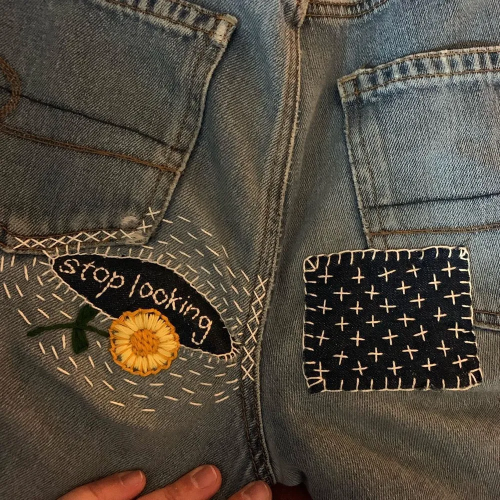
(Image source)
In this example, The Woolery Guy chose to use flower embroidery to make a hole in a knit fabric look like it was there by design:

(Image source)
For more examples, check out Pinterest or VisibleMending.com.
Conclusion:
Embroidery is a useful skill to give new life to your wardrobe. You can use it to give some flair to items you've grown bored off, or even to mend your clothes.
Once you've got a few basic stitches under your belt, the possibilities are endless. Be creative and have fun with it!
Good luck and feel free to show me your work!
Cultural/Childhood Headcanons for Sevika!!!!

As we know Sevika is South Asian coded and though that specific culture does not necessarily exist in Runeterra, I still like to think there'd be some type of Desi culture for her and other characters coded similarly.
When she was young, her mother used to do Henna! Birthday's, holidays or any occasion that was special or could considered special to Sevika or her family. Maybe not the most intricate or skilled, but it made Sevika happy! As she got older her mom showed her how to basic designs so they would be able to having matching or similar artwork on their hands, feet or arms.
I can really see Sevika having longer hair as a child (even though short hair baby Sev is the cutest!!!), and same with her mother. Maybe not crazy long down to the floor, but a considerable length (Let's say it stopped around mid back). They'd have one day a week that they washed and oiled their hair, not only for the maintenance but bonding, and I'd like to think Sevika would really look for to those days <3
I'd really like to think Sevika is a chai snob(This HC is from a friend). Growing up it might've not made appearance often but when it did, her parents made the beverage better than anyone in Runeterra. Therefore, unless she makes it herself (She will do this often, especially after giving up drinking, and getting closer with Jinx and Isha who are now also chai snobs), she's not impressed. Merchants might use too much milk, or the tea didn't steep long enough, or maybe the cloves have lost their potency. Whatever the reason, Sevika is extremely critical of her favorite drink, and is convinced that only she can create the perfect chai.
Sevika growing up would get into her mother's makeup, always going for the same color lipstick and kajal her mother used. Getting older, perhaps as teenager, she would if she couldn't afford or find it in the Undercity would venture topside and swipe the lipstick shade and eye makeup from the Piltover version of Sephora
My last cultural headcanon is that Sevika and her mother would sometimes wear Sarees! Maybe not out and about in the Undercity often, but definitely dressed up at home. Specifically that same burgundy reddish shade of her cloak (who someone pointed out on twt is worn like an Indian shawl!)
Upon finishing this list I realize this is Mother/Daughter leaning HC's so I think I will do some Father/Daughter HC's next :)
-
 clearly-astraea reblogged this · 2 months ago
clearly-astraea reblogged this · 2 months ago -
 clearly-astraea liked this · 2 months ago
clearly-astraea liked this · 2 months ago -
 woosjisi liked this · 2 months ago
woosjisi liked this · 2 months ago -
 toiletepaperroll liked this · 2 months ago
toiletepaperroll liked this · 2 months ago -
 taygracie liked this · 2 months ago
taygracie liked this · 2 months ago -
 prettysureimlost liked this · 2 months ago
prettysureimlost liked this · 2 months ago -
 muchlove-judge liked this · 2 months ago
muchlove-judge liked this · 2 months ago -
 madman-or-poet liked this · 2 months ago
madman-or-poet liked this · 2 months ago -
 johnnyonthespot65 liked this · 2 months ago
johnnyonthespot65 liked this · 2 months ago -
 plunkfish2 liked this · 2 months ago
plunkfish2 liked this · 2 months ago -
 eatingpastr13s liked this · 2 months ago
eatingpastr13s liked this · 2 months ago -
 letmegues liked this · 2 months ago
letmegues liked this · 2 months ago -
 lovingpeggyc liked this · 2 months ago
lovingpeggyc liked this · 2 months ago -
 surpriseimbored liked this · 2 months ago
surpriseimbored liked this · 2 months ago -
 cloudz2095 liked this · 2 months ago
cloudz2095 liked this · 2 months ago -
 3-2-4 reblogged this · 2 months ago
3-2-4 reblogged this · 2 months ago -
 selkiesmile liked this · 3 months ago
selkiesmile liked this · 3 months ago -
 1ovetimmy liked this · 3 months ago
1ovetimmy liked this · 3 months ago -
 jenoismysavior liked this · 5 months ago
jenoismysavior liked this · 5 months ago -
 k7mi liked this · 8 months ago
k7mi liked this · 8 months ago -
 squashonesquashtwosquashthree reblogged this · 10 months ago
squashonesquashtwosquashthree reblogged this · 10 months ago -
 coldpuppyluminary liked this · 11 months ago
coldpuppyluminary liked this · 11 months ago -
 notintersetedinliving liked this · 11 months ago
notintersetedinliving liked this · 11 months ago -
 masterbanana777 liked this · 11 months ago
masterbanana777 liked this · 11 months ago -
 mcrrina liked this · 11 months ago
mcrrina liked this · 11 months ago -
 papierfliegerchen liked this · 11 months ago
papierfliegerchen liked this · 11 months ago -
 kafkaesquegf liked this · 1 year ago
kafkaesquegf liked this · 1 year ago -
 adventuringblind liked this · 1 year ago
adventuringblind liked this · 1 year ago -
 i-have-too-much-time reblogged this · 1 year ago
i-have-too-much-time reblogged this · 1 year ago -
 i-have-too-much-time liked this · 1 year ago
i-have-too-much-time liked this · 1 year ago -
 inejghafawifesblog liked this · 1 year ago
inejghafawifesblog liked this · 1 year ago -
 81wdcs reblogged this · 1 year ago
81wdcs reblogged this · 1 year ago -
 dijiaaaaaa liked this · 1 year ago
dijiaaaaaa liked this · 1 year ago -
 saffry1633 liked this · 1 year ago
saffry1633 liked this · 1 year ago -
 jethro-in-the-tardis liked this · 1 year ago
jethro-in-the-tardis liked this · 1 year ago -
 decaffeinatedfishherringpur-blog liked this · 1 year ago
decaffeinatedfishherringpur-blog liked this · 1 year ago -
 rubywingsracing liked this · 1 year ago
rubywingsracing liked this · 1 year ago -
 originalposterpiastri reblogged this · 1 year ago
originalposterpiastri reblogged this · 1 year ago -
 circusvet liked this · 1 year ago
circusvet liked this · 1 year ago -
 sh0uldhave liked this · 1 year ago
sh0uldhave liked this · 1 year ago -
 randomfinny liked this · 1 year ago
randomfinny liked this · 1 year ago -
 serve-cunt liked this · 1 year ago
serve-cunt liked this · 1 year ago -
 keepersoftheweather liked this · 1 year ago
keepersoftheweather liked this · 1 year ago -
 strawberry-daiquiris reblogged this · 1 year ago
strawberry-daiquiris reblogged this · 1 year ago -
 boonmeams liked this · 1 year ago
boonmeams liked this · 1 year ago -
 maggotxiv liked this · 1 year ago
maggotxiv liked this · 1 year ago -
 frogwithmask liked this · 1 year ago
frogwithmask liked this · 1 year ago -
 alwayssortbykudos liked this · 1 year ago
alwayssortbykudos liked this · 1 year ago -
 mhcranberry liked this · 1 year ago
mhcranberry liked this · 1 year ago -
 ruledbyproblematique reblogged this · 1 year ago
ruledbyproblematique reblogged this · 1 year ago
